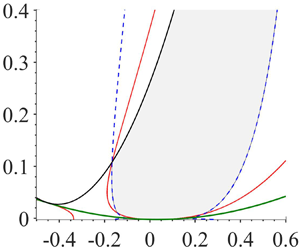Published online by Cambridge University Press: 04 November 2020

Stability of hexagonal patterns in Rayleigh–Bénard convection for shear-thinning fluids with temperature-dependent viscosity is studied in the framework of amplitude equations. The rheological behaviour of the fluid is described by the Carreau model and the relationship between the viscosity and the temperature is of exponential type. Ginzburg–Landau equations including non-variational quadratic spatial terms are derived explicitly from the basic hydrodynamic equations using a multiple scale expansion. The stability of hexagonal patterns towards spatially uniform disturbances (amplitude instabilities) and to long wavelength perturbations (phase instabilities) is analysed for different values of the shear-thinning degree  $\alpha$ of the fluid and the ratio
$\alpha$ of the fluid and the ratio  $r$ of the viscosities between the top and bottom walls. It is shown that the amplitude stability domain shrinks with increasing shear-thinning effects and increases with increasing the viscosity ratio
$r$ of the viscosities between the top and bottom walls. It is shown that the amplitude stability domain shrinks with increasing shear-thinning effects and increases with increasing the viscosity ratio  $r$. Concerning the phase stability domain which confines the range of stable wavenumbers, it is shown that it is closed for low values of
$r$. Concerning the phase stability domain which confines the range of stable wavenumbers, it is shown that it is closed for low values of  $r$ and becomes open and asymmetric for moderate values of
$r$ and becomes open and asymmetric for moderate values of  $r$. With increasing shear-thinning effects, the phase stability domain becomes more decentred towards higher values of the wavenumber. Beyond the stability limits, two different modes go unstable: longitudinal and transverse modes. For the parameters considered here, the longitudinal mode is relevant only in a small region close to the onset. The nonlinear evolution of the transverse phase instability is investigated by numerical integration of amplitude equations. The hexagon–roll transition triggered by the transverse phase instability for sufficiently large reduced Rayleigh number
$r$. With increasing shear-thinning effects, the phase stability domain becomes more decentred towards higher values of the wavenumber. Beyond the stability limits, two different modes go unstable: longitudinal and transverse modes. For the parameters considered here, the longitudinal mode is relevant only in a small region close to the onset. The nonlinear evolution of the transverse phase instability is investigated by numerical integration of amplitude equations. The hexagon–roll transition triggered by the transverse phase instability for sufficiently large reduced Rayleigh number  $\epsilon$ is illustrated.
$\epsilon$ is illustrated.